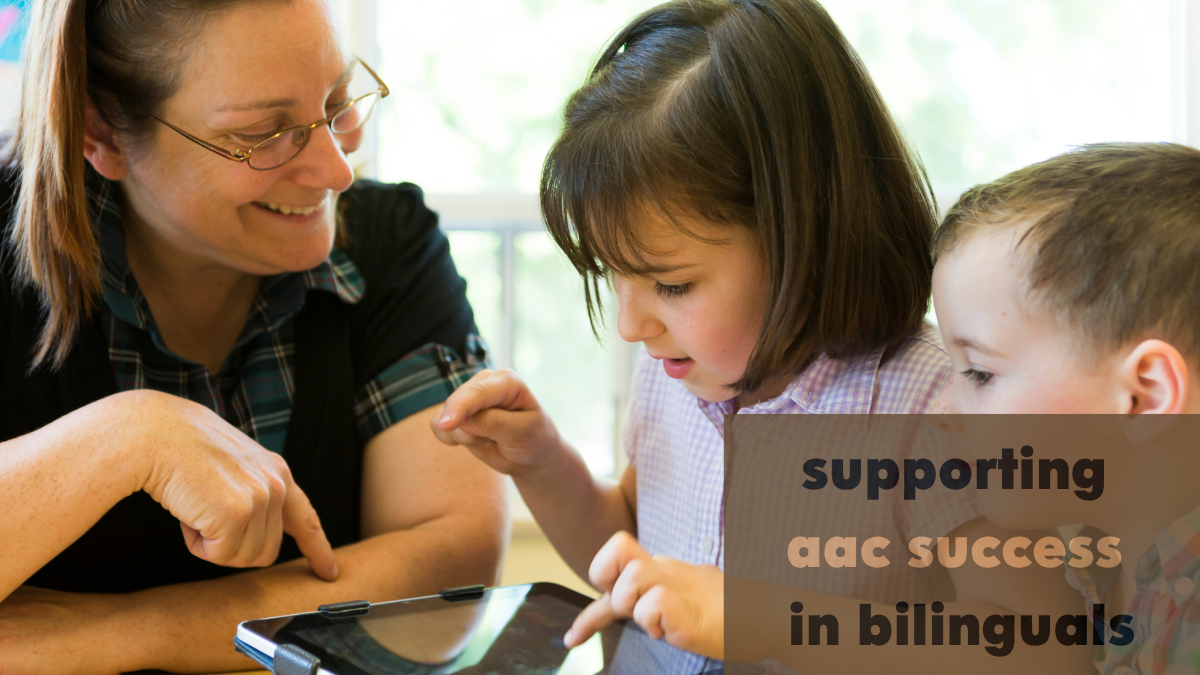Parents starting their journey with AAC have many questions and doubts. Find answers to all your doubts and more, in this blog by SLP Niveditha. This is Part 2 of this series. Read Part 1 here.
Engaging a Child Who Isn’t Looking at the Device
“The child is not looking at the device” is the most common concern for many parents. This makes them think that their child may not be ready for AAC. Some choose to wait and see. This approach is inappropriate as it delays communication and academic goals.
Instead, try a couple of ideas from below:
Positioning:
Try altering your position or that of the users so that you are slightly lower than the child’s eye level. The child will be able to see the app and you easily. You should aim to face the child rather than modeling from behind.


Special Interests:
Emergent communicators often have specific interests. When we include those interests while modeling communication, we can have better outcomes.
Follow the Child:
Following the child and taking cues from them is a powerful practice. Observe what they are looking at or doing. Pay attention to their body language and facial expressions. This will help you understand their messages about the world around them. Give language to all the nonverbal communication that takes place. Model it on their AAC using language strategies like Verbal referencing and attributing meaning.
Imitation:
We can try engaging the communicator by imitating what they are doing – be it self-stimulatory body movements or vocalizations. Imitating them is one of the best ways to get their attention. Once they engage, you can slowly add language with ALI (Aided Language Input).
Expanding Communication Beyond Basic Needs
In our daily lives, we communicate for a variety of reasons and purposes. Hence, it is important that we expose communicators to using AAC in different situations by modeling the same.
It is standard practice to start with requesting. We model to the user that requesting with the device helps them get what they need and want. This is quite motivating as well. That said, it is crucial that we keep moving to other functions and don’t get stuck on only requesting. Getting the user to only request with the device may lead to:
- Limited conversation with the AAC user. No real conversation is possible with only requesting.
- Lowered expectations from AAC users.
- It can easily become a teaching strategy especially when asked to do it again and again.
Navigating AAC Challenges at School
Parents who have become comfortable using AAC at home are unwilling to send it to school. Here are some common reasons and some suggestions to overcome them:
1. Device Safety
A lot of parent concerns are to do with the consequences of throwing, banging etc. Some steps can help mitigate unavoidable circumstances.
- Cover the iPad or tablet that you are using with a strong and sturdy case.
- Consider using a protective screen guard.
- Attach a strap to the device so it can be easily and safely carried around.
- Back-up your child’s AAC data. Most AAC apps will have a tool to back-up and store your app’s data in a safe space for easy retrieval.
2. School Staff Unwilling to use AAC Due to Lack of Time
At the outset, the school staff would need to invest time to learn about AAC and its basic strategies. Once they do, that they will slowly realize that AAC helps them do their work effectively and efficiently. A small effort brings in long term dividends. We can advocate these benefits at the school for AAC implementation:


- Children using AAC are able to communicate their needs clearly, leading to better behavior in the classroom.
- They participate more in classroom discussions because now they can say whatever is on their mind.
- It helps them understand the educational concepts and express their understanding too. This removes the guesswork done by teachers about the child’s understanding.
All of this leads to better social relationships in the classroom and reduces meltdowns!
3. A Distraction for Other Students
All children are familiar with iPads and tablets and may be curious about how this app works. Teachers can introduce the device to the entire class to explain how it works and helps the user. If the user is willing, peers may try to use the device too for a brief time. Once this is done, we can take help from peers to model for the user. In time, they may even become great communication partners.
There are other features in the app that can be modified to make the app less distracting. One such is the touch response bar for speaking. It can be customised such that it helps the user speak their answer as a whole rather than speak every word tapped.
Modeling Phrases for Improved Communication
When communication partners model AAC for a user, SLPs recommend using the 1 up rule. That is, we model 1 word above the user’s current usage. If the child is just starting on the device, model single words. If the child is using 1 word on the AAC system, model 2 words, and so on.
There are situations when we recommend modeling a phrase or a simple sentence, such as those mentioned below
- When communicating quickly for an emergency: “I WANT TO GO TO TOILET”
- A quick social exchange: “I AM FINE THANK YOU”
- Modeling for a user who is a Gestalt Language Processor. Here we initially record and model their favorite phrases from YouTube to get them interested in the device. Eventually, we start reducing them as the user moves through different levels of GLP.
While modeling, it is important to target various communicative functions across contexts.
Managing Device Accessibility
Communication happens anywhere and everywhere. Hence, the device should be available for use at every opportunity. Device accessibility is of utmost importance to the user, for obvious reasons. It applies to communication partners as well – so that they are able to model at all times.
It is possible that sometimes we feel that we have lost a modeling opportunity because the device was not with us. Or situations where the device battery is running low etc. Here are some tips to avoid this:
- Charge the device at a consistent time of the day to make sure the battery does not die.
- Consider having the app on your phone too. Even if you forget to take the device, you still can model with your phone. This is especially useful because our phones tend to stay with us wherever we go!
- Consider having low-tech backups in the form of core boards/flip books. Put these up at different places in the house so that AAC is always accessible. For example: the refrigerator or the dining table, the bathroom, bedroom, the living room etc.
Promoting Consistent AAC Use Across Family Members
Success with AAC to a large extent depends on the AAC system and the support that the user gets. Consistent modeling by everyone at home is crucial for the user to realize that AAC is a part of their home and is an acceptable way of communication.
Modeling with AAC does not come naturally at the beginning because it is new and different from communicating with speech. It is difficult trying to remember to use the device at every communication opportunity. Finding the symbols that you want to model on demand takes getting used to. All of this may take time initially – but when done consistently, everyone will get better at it.
Even if your modeling amounts to short periods of time each day, just imagine if everybody does their share. One parent models during meal time and another parent or family member does so during playtime. A sibling can model during book reading and so on. It ALL adds to a great benefit to the AAC communicator!
So as a family, learn modeling and become more confident TOGETHER. Share the joys of communication with your user!
We extend our sincere gratitude to Preeja Balan, Director of Octave Hearing and Speech Centre, for sharing her original insights that laid the groundwork for this informative piece..
WRITTEN BY
Hannah Rahman
I am a certified Speech-Language Pathologist with years of clinical experience. I have worked in both school and rehabilitation settings, providing therapy for children and adults with speech, language, communication, and swallowing disorders. I incorporate sensory integration strategies to bring a holistic shift in functional communication—helping individuals connect, express, and engage more meaningfully in their daily lives.





